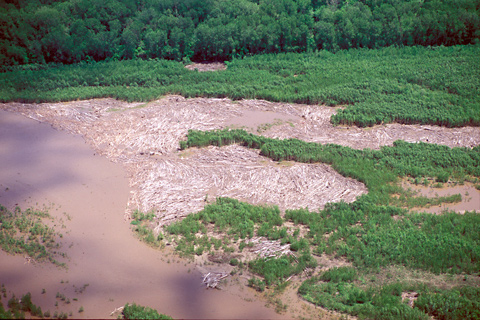In Lewis and Clark’s day, a lexicon of hazards made up an intimate dialog between the riverman and the river. Snag, sweep, sawyers, preacher, rapid, riffle, eddy, and whirlpool; rolling sands, rocky shoals, collapsing banks, and overhanging trees. The photo shows a drift or raft of logs—an embarras, or “obstacle,” as the French engagés called it. Rising waters in the spring dislodged downed timber, then carried it to the nearest place where it could be caught and collected. Huge drifts could accumulate rapidly. Receding waters left them beached in the mud, to be picked up again the following spring and moved on. The Missouri spawned countless hazards such as these throughout its length, and even contributed some of them to the Mississippi River
Drifts like the one pictured were even more dangerous on the downstream journey than they were going upriver, with the current in this part of the Missouri running at an estimated six and a half to seven miles per hour. To maintain control and avoid slamming into them, the men of the Corps had to keep the boats moving faster than the current. If a craft were caught against the leading edge of a drift, it would be next to impossible for the crew to escape.
From Discovering Lewis & Clark from the Air
Photography by Jim Wark
Text by Joseph Mussulman
Reproduced by permission of Mountain Press

